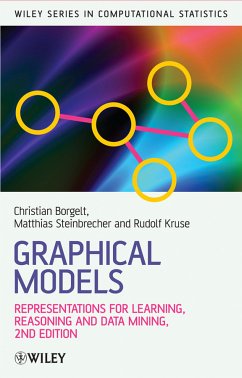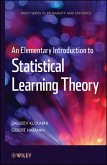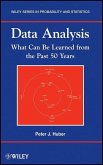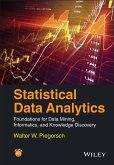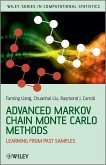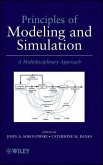Christian Borgelt, Matthias Steinbrecher, Rudolf R. Kruse
Graphical Models (eBook, PDF)
Representations for Learning, Reasoning and Data Mining
99,99 €
99,99 €
inkl. MwSt.
Sofort per Download lieferbar

0 °P sammeln
99,99 €
Als Download kaufen

99,99 €
inkl. MwSt.
Sofort per Download lieferbar

0 °P sammeln
Jetzt verschenken
Alle Infos zum eBook verschenken
99,99 €
inkl. MwSt.
Sofort per Download lieferbar
Alle Infos zum eBook verschenken

0 °P sammeln
Christian Borgelt, Matthias Steinbrecher, Rudolf R. Kruse
Graphical Models (eBook, PDF)
Representations for Learning, Reasoning and Data Mining
- Format: PDF
- Merkliste
- Auf die Merkliste
- Bewerten Bewerten
- Teilen
- Produkt teilen
- Produkterinnerung
- Produkterinnerung

Bitte loggen Sie sich zunächst in Ihr Kundenkonto ein oder registrieren Sie sich bei
bücher.de, um das eBook-Abo tolino select nutzen zu können.
Hier können Sie sich einloggen
Hier können Sie sich einloggen
Sie sind bereits eingeloggt. Klicken Sie auf 2. tolino select Abo, um fortzufahren.

Bitte loggen Sie sich zunächst in Ihr Kundenkonto ein oder registrieren Sie sich bei bücher.de, um das eBook-Abo tolino select nutzen zu können.
Graphical models are of increasing importance in applied statistics, and in particular in data mining. Providing a self-contained introduction and overview to learning relational, probabilistic, and possibilistic networks from data, this second edition of Graphical Models is thoroughly updated to include the latest research in this burgeoning field, including a new chapter on visualization. The text provides graduate students, and researchers with all the necessary background material, including modelling under uncertainty, decomposition of distributions, graphical representation of…mehr
- Geräte: PC
- mit Kopierschutz
- eBook Hilfe
- Größe: 2.78MB
Andere Kunden interessierten sich auch für
![An Elementary Introduction to Statistical Learning Theory (eBook, PDF) An Elementary Introduction to Statistical Learning Theory (eBook, PDF)]() Sanjeev KulkarniAn Elementary Introduction to Statistical Learning Theory (eBook, PDF)109,99 €
Sanjeev KulkarniAn Elementary Introduction to Statistical Learning Theory (eBook, PDF)109,99 €![Text Mining (eBook, PDF) Text Mining (eBook, PDF)]() Text Mining (eBook, PDF)80,99 €
Text Mining (eBook, PDF)80,99 €![Data Analysis (eBook, PDF) Data Analysis (eBook, PDF)]() Peter J. HuberData Analysis (eBook, PDF)116,99 €
Peter J. HuberData Analysis (eBook, PDF)116,99 €![Statistical Data Analytics (eBook, PDF) Statistical Data Analytics (eBook, PDF)]() Walter W. PiegorschStatistical Data Analytics (eBook, PDF)83,99 €
Walter W. PiegorschStatistical Data Analytics (eBook, PDF)83,99 €![Modeling and Simulation for Analyzing Global Events (eBook, PDF) Modeling and Simulation for Analyzing Global Events (eBook, PDF)]() John A. SokolowskiModeling and Simulation for Analyzing Global Events (eBook, PDF)107,99 €
John A. SokolowskiModeling and Simulation for Analyzing Global Events (eBook, PDF)107,99 €![Advanced Markov Chain Monte Carlo Methods (eBook, PDF) Advanced Markov Chain Monte Carlo Methods (eBook, PDF)]() Faming LiangAdvanced Markov Chain Monte Carlo Methods (eBook, PDF)96,99 €
Faming LiangAdvanced Markov Chain Monte Carlo Methods (eBook, PDF)96,99 €![Principles of Modeling and Simulation (eBook, PDF) Principles of Modeling and Simulation (eBook, PDF)]() Principles of Modeling and Simulation (eBook, PDF)114,99 €
Principles of Modeling and Simulation (eBook, PDF)114,99 €-
-
-
Graphical models are of increasing importance in applied statistics, and in particular in data mining. Providing a self-contained introduction and overview to learning relational, probabilistic, and possibilistic networks from data, this second edition of Graphical Models is thoroughly updated to include the latest research in this burgeoning field, including a new chapter on visualization. The text provides graduate students, and researchers with all the necessary background material, including modelling under uncertainty, decomposition of distributions, graphical representation of distributions, and applications relating to graphical models and problems for further research.
Dieser Download kann aus rechtlichen Gründen nur mit Rechnungsadresse in D ausgeliefert werden.
Produktdetails
- Produktdetails
- Verlag: John Wiley & Sons
- Erscheinungstermin: 30. Juli 2009
- Englisch
- ISBN-13: 9780470749562
- Artikelnr.: 37299177
- Verlag: John Wiley & Sons
- Erscheinungstermin: 30. Juli 2009
- Englisch
- ISBN-13: 9780470749562
- Artikelnr.: 37299177
- Herstellerkennzeichnung Die Herstellerinformationen sind derzeit nicht verfügbar.
Christian Borgelt, is the Principal researcher at the European Centre for Soft Computing at Otto-von-Guericke University of Magdeburg.
Rudolf Kruse, Professor for Computer Science at Otto-von-Guericke University of Magdeburg.
Matthias Steinbrecher, Department of Knowledge Processing and Language Engineering, School of Computer Science, Universitätsplatz 2,?Magdeburg, Germany.
Rudolf Kruse, Professor for Computer Science at Otto-von-Guericke University of Magdeburg.
Matthias Steinbrecher, Department of Knowledge Processing and Language Engineering, School of Computer Science, Universitätsplatz 2,?Magdeburg, Germany.
Preface.
1 Introduction.
1.1 Data and Knowledge.
1.2 Knowledge Discovery and Data Mining.
1.3 Graphical Models.
1.4 Outline of this Book.
2 Imprecision and Uncertainty.
2.1 Modeling Inferences.
2.2 Imprecision and Relational Algebra.
2.3 Uncertainty and Probability Theory.
2.4 Possibility Theory and the Context Model.
3 Decomposition.
3.1 Decomposition and Reasoning.
3.2 Relational Decomposition.
3.3 Probabilistic Decomposition.
3.4 Possibilistic Decomposition.
3.5 Possibility versus Probability.
4 Graphical Representation.
4.1 Conditional Independence Graphs.
4.2 Evidence Propagation in Graphs.
5 Computing Projections.
5.1 Databases of Sample Cases.
5.2 Relational and Sum Projections.
5.3 Expectation Maximization.
5.4 Maximum Projections.
6 Naive Classifiers.
6.1 Naive Bayes Classifiers.
6.2 A Naive Possibilistic Classifier.
6.3 Classifier Simplification.
6.4 Experimental Evaluation.
7 Learning Global Structure.
7.1 Principles of Learning Global Structure.
7.2 Evaluation Measures.
7.3 Search Methods.
7.4 Experimental Evaluation.
8 Learning Local Structure.
8.1 Local Network Structure.
8.2 Learning Local Structure.
8.3 Experimental Evaluation.
9 Inductive Causation.
9.1 Correlation and Causation.
9.2 Causal and Probabilistic Structure.
9.3 Faithfulness and Latent Variables.
9.4 The Inductive Causation Algorithm.
9.5 Critique of the Underlying Assumptions.
9.6 Evaluation.
10 Visualization.
10.1 Potentials.
10.2 Association Rules.
11 Applications.
11.1 Diagnosis of Electrical Circuits.
11.2 Application in Telecommunications.
11.3 Application at Volkswagen.
11.4 Application at DaimlerChrysler.
A Proofs of Theorems.
A.1 Proof of Theorem 4.1.2.
A.2 Proof of Theorem 4.1.18.
A.3 Proof of Theorem 4.1.20.
A.4 Proof of Theorem 4.1.26.
A.5 Proof of Theorem 4.1.28.
A.6 Proof of Theorem 4.1.30.
A.7 Proof of Theorem 4.1.31.
A.8 Proof of Theorem 5.4.8.
A.9 Proof of Lemma .2.2.
A.10 Proof of Lemma .2.4.
A.11 Proof of Lemma .2.6.
A.12 Proof of Theorem 7.3.1.
A.13 Proof of Theorem 7.3.2.
A.14 Proof of Theorem 7.3.3.
A.15 Proof of Theorem 7.3.5.
A.16 Proof of Theorem 7.3.7.
B Software Tools.
Bibliography.
Index.
1 Introduction.
1.1 Data and Knowledge.
1.2 Knowledge Discovery and Data Mining.
1.3 Graphical Models.
1.4 Outline of this Book.
2 Imprecision and Uncertainty.
2.1 Modeling Inferences.
2.2 Imprecision and Relational Algebra.
2.3 Uncertainty and Probability Theory.
2.4 Possibility Theory and the Context Model.
3 Decomposition.
3.1 Decomposition and Reasoning.
3.2 Relational Decomposition.
3.3 Probabilistic Decomposition.
3.4 Possibilistic Decomposition.
3.5 Possibility versus Probability.
4 Graphical Representation.
4.1 Conditional Independence Graphs.
4.2 Evidence Propagation in Graphs.
5 Computing Projections.
5.1 Databases of Sample Cases.
5.2 Relational and Sum Projections.
5.3 Expectation Maximization.
5.4 Maximum Projections.
6 Naive Classifiers.
6.1 Naive Bayes Classifiers.
6.2 A Naive Possibilistic Classifier.
6.3 Classifier Simplification.
6.4 Experimental Evaluation.
7 Learning Global Structure.
7.1 Principles of Learning Global Structure.
7.2 Evaluation Measures.
7.3 Search Methods.
7.4 Experimental Evaluation.
8 Learning Local Structure.
8.1 Local Network Structure.
8.2 Learning Local Structure.
8.3 Experimental Evaluation.
9 Inductive Causation.
9.1 Correlation and Causation.
9.2 Causal and Probabilistic Structure.
9.3 Faithfulness and Latent Variables.
9.4 The Inductive Causation Algorithm.
9.5 Critique of the Underlying Assumptions.
9.6 Evaluation.
10 Visualization.
10.1 Potentials.
10.2 Association Rules.
11 Applications.
11.1 Diagnosis of Electrical Circuits.
11.2 Application in Telecommunications.
11.3 Application at Volkswagen.
11.4 Application at DaimlerChrysler.
A Proofs of Theorems.
A.1 Proof of Theorem 4.1.2.
A.2 Proof of Theorem 4.1.18.
A.3 Proof of Theorem 4.1.20.
A.4 Proof of Theorem 4.1.26.
A.5 Proof of Theorem 4.1.28.
A.6 Proof of Theorem 4.1.30.
A.7 Proof of Theorem 4.1.31.
A.8 Proof of Theorem 5.4.8.
A.9 Proof of Lemma .2.2.
A.10 Proof of Lemma .2.4.
A.11 Proof of Lemma .2.6.
A.12 Proof of Theorem 7.3.1.
A.13 Proof of Theorem 7.3.2.
A.14 Proof of Theorem 7.3.3.
A.15 Proof of Theorem 7.3.5.
A.16 Proof of Theorem 7.3.7.
B Software Tools.
Bibliography.
Index.
Preface.
1 Introduction.
1.1 Data and Knowledge.
1.2 Knowledge Discovery and Data Mining.
1.3 Graphical Models.
1.4 Outline of this Book.
2 Imprecision and Uncertainty.
2.1 Modeling Inferences.
2.2 Imprecision and Relational Algebra.
2.3 Uncertainty and Probability Theory.
2.4 Possibility Theory and the Context Model.
3 Decomposition.
3.1 Decomposition and Reasoning.
3.2 Relational Decomposition.
3.3 Probabilistic Decomposition.
3.4 Possibilistic Decomposition.
3.5 Possibility versus Probability.
4 Graphical Representation.
4.1 Conditional Independence Graphs.
4.2 Evidence Propagation in Graphs.
5 Computing Projections.
5.1 Databases of Sample Cases.
5.2 Relational and Sum Projections.
5.3 Expectation Maximization.
5.4 Maximum Projections.
6 Naive Classifiers.
6.1 Naive Bayes Classifiers.
6.2 A Naive Possibilistic Classifier.
6.3 Classifier Simplification.
6.4 Experimental Evaluation.
7 Learning Global Structure.
7.1 Principles of Learning Global Structure.
7.2 Evaluation Measures.
7.3 Search Methods.
7.4 Experimental Evaluation.
8 Learning Local Structure.
8.1 Local Network Structure.
8.2 Learning Local Structure.
8.3 Experimental Evaluation.
9 Inductive Causation.
9.1 Correlation and Causation.
9.2 Causal and Probabilistic Structure.
9.3 Faithfulness and Latent Variables.
9.4 The Inductive Causation Algorithm.
9.5 Critique of the Underlying Assumptions.
9.6 Evaluation.
10 Visualization.
10.1 Potentials.
10.2 Association Rules.
11 Applications.
11.1 Diagnosis of Electrical Circuits.
11.2 Application in Telecommunications.
11.3 Application at Volkswagen.
11.4 Application at DaimlerChrysler.
A Proofs of Theorems.
A.1 Proof of Theorem 4.1.2.
A.2 Proof of Theorem 4.1.18.
A.3 Proof of Theorem 4.1.20.
A.4 Proof of Theorem 4.1.26.
A.5 Proof of Theorem 4.1.28.
A.6 Proof of Theorem 4.1.30.
A.7 Proof of Theorem 4.1.31.
A.8 Proof of Theorem 5.4.8.
A.9 Proof of Lemma .2.2.
A.10 Proof of Lemma .2.4.
A.11 Proof of Lemma .2.6.
A.12 Proof of Theorem 7.3.1.
A.13 Proof of Theorem 7.3.2.
A.14 Proof of Theorem 7.3.3.
A.15 Proof of Theorem 7.3.5.
A.16 Proof of Theorem 7.3.7.
B Software Tools.
Bibliography.
Index.
1 Introduction.
1.1 Data and Knowledge.
1.2 Knowledge Discovery and Data Mining.
1.3 Graphical Models.
1.4 Outline of this Book.
2 Imprecision and Uncertainty.
2.1 Modeling Inferences.
2.2 Imprecision and Relational Algebra.
2.3 Uncertainty and Probability Theory.
2.4 Possibility Theory and the Context Model.
3 Decomposition.
3.1 Decomposition and Reasoning.
3.2 Relational Decomposition.
3.3 Probabilistic Decomposition.
3.4 Possibilistic Decomposition.
3.5 Possibility versus Probability.
4 Graphical Representation.
4.1 Conditional Independence Graphs.
4.2 Evidence Propagation in Graphs.
5 Computing Projections.
5.1 Databases of Sample Cases.
5.2 Relational and Sum Projections.
5.3 Expectation Maximization.
5.4 Maximum Projections.
6 Naive Classifiers.
6.1 Naive Bayes Classifiers.
6.2 A Naive Possibilistic Classifier.
6.3 Classifier Simplification.
6.4 Experimental Evaluation.
7 Learning Global Structure.
7.1 Principles of Learning Global Structure.
7.2 Evaluation Measures.
7.3 Search Methods.
7.4 Experimental Evaluation.
8 Learning Local Structure.
8.1 Local Network Structure.
8.2 Learning Local Structure.
8.3 Experimental Evaluation.
9 Inductive Causation.
9.1 Correlation and Causation.
9.2 Causal and Probabilistic Structure.
9.3 Faithfulness and Latent Variables.
9.4 The Inductive Causation Algorithm.
9.5 Critique of the Underlying Assumptions.
9.6 Evaluation.
10 Visualization.
10.1 Potentials.
10.2 Association Rules.
11 Applications.
11.1 Diagnosis of Electrical Circuits.
11.2 Application in Telecommunications.
11.3 Application at Volkswagen.
11.4 Application at DaimlerChrysler.
A Proofs of Theorems.
A.1 Proof of Theorem 4.1.2.
A.2 Proof of Theorem 4.1.18.
A.3 Proof of Theorem 4.1.20.
A.4 Proof of Theorem 4.1.26.
A.5 Proof of Theorem 4.1.28.
A.6 Proof of Theorem 4.1.30.
A.7 Proof of Theorem 4.1.31.
A.8 Proof of Theorem 5.4.8.
A.9 Proof of Lemma .2.2.
A.10 Proof of Lemma .2.4.
A.11 Proof of Lemma .2.6.
A.12 Proof of Theorem 7.3.1.
A.13 Proof of Theorem 7.3.2.
A.14 Proof of Theorem 7.3.3.
A.15 Proof of Theorem 7.3.5.
A.16 Proof of Theorem 7.3.7.
B Software Tools.
Bibliography.
Index.
